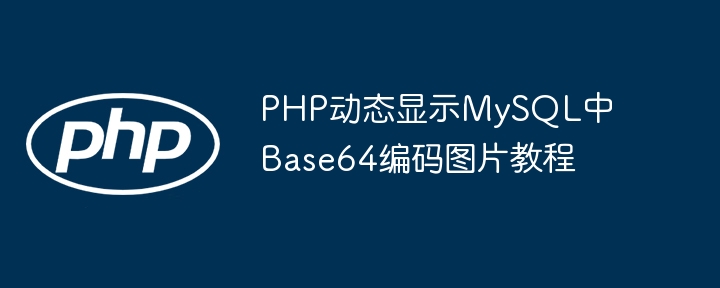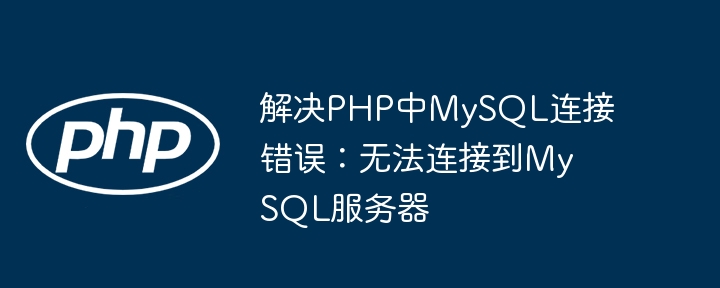Found a total of 10000 related content

How to connect PHP script to MySQL database
Article Introduction:In online form development, connecting PHP code with MySQL database is a common operation. User form data needs to be collected and added to the database. This article introduces two commonly used PHP and MySQL database connection methods.
PHP and MySQL database connection
To connect MySQL database to PHP, you need to install MySQL, database management tools and PHP on your computer. The two most commonly used connection methods are MySQLi and PDO.
First, we introduce the easier MySQLi to use.
First create a MySQL database, here we use TablePlus. TablePlus is a convenient database management tool that handles a variety of databases in a single interface. Through its user-friendly interface,
2025-04-11
comment 0
756


PHP database query results: Practical guide to implementing primary key ID as array key
Article Introduction:This tutorial will guide you how to convert data queried from a MySQL database into a PHP array and use the unique ID field in the database as the key to the array. This approach greatly improves data access efficiency and code readability, especially for scenarios where specific records need to be retrieved quickly by ID. We will show how to implement this common database operation optimization through specific code examples.
2025-08-27
comment 0
900

PHP dynamically displaying Base64 encoding picture tutorial in MySQL
Article Introduction:This tutorial explains in detail how to use PHP to retrieve and dynamically display Base64-encoded pictures from a MySQL database. The core is to ensure that the database stores a complete Data URI format string and output it directly into the src attribute of HTML tags through PHP, avoiding unnecessary secondary encoding and string processing, thereby effectively solving the problem that the image cannot be displayed normally.
2025-09-01
comment 0
513

Can I reset a database user password using Navicat?
Article Introduction:Yes, you can reset the database user password through Navicat. The specific steps are: 1. Right-click the database server connected to it and select "Manage Users"; 2. Find the user who needs to modify the password and click Edit; 3. Enter and confirm the new password in the pop-up window; 4. Save the changes. Some databases such as MySQL may require the FLUSHPRIVILEGES command to make the changes take effect. If there is no administrator permission, you need to request administrator assistance or use the command line operation. Common errors include choosing the wrong database type, not saving changes, using weak passwords, and mistakenly changing other user information. When it comes to complex authentication methods such as LDAP or OAuth, you may need to rely on native tools to complete the operation.
2025-07-27
comment 0
299

mysql command line client tips
Article Introduction:Mastering common techniques of MySQL command line can improve operation efficiency; configuring default login information can quickly enter the database interface; using up and down keys or systemhistory to view historical commands, the Tab key will automatically complete the table name field; using \G vertically display results and pagermore pagination display; using shortcut commands such as \s to view connection status, \c cancel statement, \g execution statement, and \h to obtain help documents.
2025-07-14
comment 0
192

Tutorial for uploading Android WebView files to MySQL database
Article Introduction:This document is intended to provide a complete tutorial on how to upload images to a MySQL database through Android WebView. The tutorial covers front-end HTML code, back-end PHP code and related precautions to help developers understand the entire upload process and successfully implement the image upload function.
2025-08-05
comment 0
816

MySQL: The Database, phpMyAdmin: The Management Interface
Article Introduction:MySQL and phpMyAdmin can be effectively managed through the following steps: 1. Create and delete database: Just click in phpMyAdmin to complete. 2. Manage tables: You can create tables, modify structures, and add indexes. 3. Data operation: Supports inserting, updating, deleting data and executing SQL queries. 4. Import and export data: Supports SQL, CSV, XML and other formats. 5. Optimization and monitoring: Use the OPTIMIZETABLE command to optimize tables and use query analyzers and monitoring tools to solve performance problems.
2025-04-29
comment 0
1114

Explain Laravel Database Migrations.
Article Introduction:Database migration is a version control tool in Laravel for managing database structure changes. It allows the use of PHP code to define and synchronize table structures to avoid manual operation of the database. 1. The migration file contains methods for up() to perform changes and down() rollback changes; 2. Use the Schema builder and Blueprint class to create tables and fields, and support common types and constraints; 3. Common Artisan commands include migrate run, rollback rollback, reset reset, refresh refresh, and make:migration to generate new files; 4. The recommended practice is to not modify the running migration, but create new files for adjustments, and fill data with factories and seeds.
2025-07-22
comment 0
742

Get MySQL database data and render it in tabular form: PHP Tutorial
Article Introduction:This tutorial is intended to help developers retrieve data from a MySQL database using PHP and store the data in tabular form. We will focus on how to use the mysqli_fetch_assoc and fetch_all functions to get query results and demonstrate how to correctly process multiple rows of data to avoid common errors of only obtaining single rows of data. Through this article, you will master the key tips for extracting complete data sets from your database.
2025-08-18
comment 0
485

Get tabular data from a MySQL database using PHP
Article Introduction:This article describes how to use PHP to retrieve and store multiple rows of data from a MySQL database as an associative array. The focus is on understanding the difference between mysqli_fetch_assoc() and mysqli_fetch_all() functions and demonstrating how to use mysqli_fetch_all() correctly to get the complete result set. With sample code, readers can learn how to efficiently extract the required data from a database and avoid the common error of getting only a single row of data.
2025-08-18
comment 0
191

How to create a custom session handler in PHP?
Article Introduction:In PHP, custom session processing mechanism requires implementing the SessionHandlerInterface interface and registering handler. 1. Implement six core methods: open(), close(), read(), write(), destroy() and gc() to complete the session storage logic; 2. Create a custom handler class instance and register it through session_set_save_handler(); 3. Call session_start() before use to start the session. Suitable for improving performance, centralized management and extension functions. It is recommended to pay attention to permission control, concurrency problems and security protection to ensure the correct operation of GC and ensure the sess
2025-07-14
comment 0
976

Base64 picture tutorial for correctly displaying database storage in PHP and HTML
Article Introduction:This tutorial aims to solve the common problem encountered when retrieving and displaying Base64 encoded images from a MySQL database using PHP and HTML, that is, the images cannot load properly. The core content is to understand the correct format of Base64 images in the HTML tag src attribute, and how to accurately extract and directly output the complete Base64 data string from the database, avoid unnecessary encoding or string operations, and ensure that the image can be correctly parsed and displayed by the browser.
2025-08-31
comment 0
346

Resolve PHP MySQL connection error: HY000/2002 Troubleshooting and best practices
Article Introduction:This tutorial aims to solve common MySQL connection errors in PHP applications, especially the "HY000/2002: A connection attempt failed" issue. The article will explore in-depth common reasons for connection failure, such as improper host address configuration, unrunning MySQL service, and incorrect file deployment location. It also provides detailed troubleshooting steps, standardized connection code examples and error handling mechanisms to help developers quickly locate and resolve database connection barriers and ensure stable operation of applications.
2025-08-19
comment 0
179

Error troubleshooting and resolution of HY000/2002 when connecting to MySQL by PHP
Article Introduction:This article discusses in detail the common HY000/2002 errors of the PHP mysqli_connect() function when connecting to a MySQL database, which usually indicates a connection timeout or the host is unresponsive. The article provides systematic troubleshooting steps, including prioritizing local connections with localhost, implementing a robust error handling mechanism, checking file deployment paths, verifying MySQL service status and network configuration. By following these guidelines and the sample code provided, developers can effectively diagnose and resolve MySQL connection issues and ensure the stable operation of the application.
2025-08-22
comment 0
930

PHP and MySQL integration: realize the percentage data saving of the score system
Article Introduction:This tutorial is designed to solve common problems in PHP backend interaction with MySQL databases, especially when dealing with form data submitted by front-end AJAX (such as percentage configuration in grade systems). We will optimize the PHP Actions class to ensure that the MySQLi database connection is correctly established and used, so as to realize reliable data storage and error handling, and improve the robustness and maintainability of the system.
2025-09-05
comment 0
408

Solve MySQL connection error in PHP: Unable to connect to MySQL server
Article Introduction:This article aims to resolve the common "Unable to connect to MySQL server" error in PHP applications, especially when using the XAMPP environment, mysqli_connect(): (HY000/2002) connection failure problem. We will explore the core reasons for such errors, such as improper host address configuration, MySQL service status abnormality, file placement location errors, etc., and provide detailed solutions, sample code and professional error handling methods to help developers quickly locate and repair database connection failures and ensure stable operation of applications.
2025-08-19
comment 0
979

How to delete duplicate rows from a table in SQL
Article Introduction:The method of deleting duplicate rows depends on the database system. Use CTE and ROW_NUMBER() to identify and retain the first row in each group, which is suitable for SQLServer, PostgreSQL and MySQL8.0; if CTE is not supported, you can create a temporary table to store deduplicate data and replace the original table; in MySQL or SQLite, you can delete duplicate records through self-connection, and keep the rows with the smallest primary key; if there is no primary key, you should first add a unique identity and then perform a deduplication operation. Before all operations, you should back up the data and preview the results with SELECT, and finally select a method suitable for the specific database and table structure to complete deduplication.
2025-08-31
comment 0
214



















